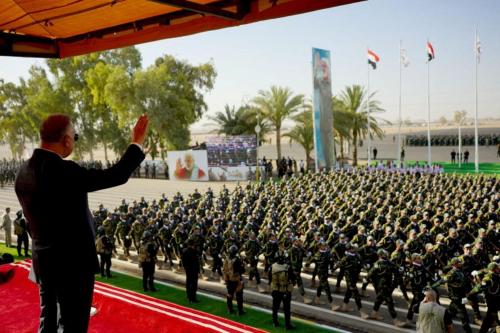Eighteen years after the 9/11 attacks and the subsequent U.S. invasion of Afghanistan, it’s clear there is no way for America to militarily win that war. With $1.5 trillion spent, thousands of American lives — and, by some estimates, hundreds of thousands of Afghan lives — lost, it’s time to end the bloodshed. If the violence cannot end with victory, the argument goes, it is best to end it with a peace deal.
Negotiating with terrorists
For all the discussion of the mechanics of the U.S.-Taliban peace deal — whether or not it will hold in the first phase that is currently underway, what phase two might look like, what sort of power-sharing arrangement might emerge between the Taliban and the Afghan government — the central question of negotiating with terrorists, and the cost of that, is not one this administration is grappling with in any significant way. (The Democratic presidential candidates even less so — both Elizabeth Warren and Pete Buttigieg have said that they will leave Afghanistan and its “endless war” with or without a peace deal; the latter would be catastrophic for Afghans.)
But this should be a central question: What is the cost of negotiating with the very terrorists who you once sought to defeat, those who are responsible for the loss of thousands of American lives and even more Afghan lives?
For Afghanistan watchers, there seems to be a recognition in narrow terms that giving the Taliban a say in government threatens gains made in women’s rights since 2001. Most observers have said that we should try to prevent these gains from being lost in whatever peace deal is signed. But how can that be guaranteed? The Taliban has never done anything other than terrorize women (and many men), and many Afghan women doubt that the Taliban will have any respect for girls’ schooling or the right of women to work, no matter what the deputy leader of the Taliban Sirajuddin Haqqani may write in the New York Times.
But while backsliding in women’s rights is at least discussed, there is little mention of the message this peace deal sends to extremists and to terrorist groups in Afghanistan and its region. The Taliban sees the deal as “America’s surrender.” That the United States was unable to defeat the Taliban will also be seen as a broader victory for the tactics and the ideology of jihadism, a dangerous thing in a region where jihadi ideologies have flourished for decades and where terrorist groups of many stripes — beyond the Afghan Taliban, ISIS, and al-Qaida, which pose the most direct danger to the United States and are thus of the most concern to the U.S. government — continue to exist.
Terrorism in Pakistan
For Pakistan — whose military routed the Pakistan Taliban, also known as the Tehrik-e-Taliban Pakistan (TTP), in an operation starting in 2014, and whose citizens largely turned against the group after it killed more than 130 schoolchildren at the Army Public School in Peshawar in 2014 — this peace deal threatens the hard-won gains of its kinetic victory against the TTP. The TTP killed tens of thousands of Pakistanis, and is closely related to the Afghan Taliban: Both pledged allegiance to the same leader, Mullah Omar. In a future where the Taliban has more control in Afghanistan, the many TTP fighters who have sought refuge in Afghanistan may feel emboldened to launch cross-border attacks on Pakistan, or to regroup and return to Pakistan’s northwest.
Of course, you could say this is in many ways Pakistan’s doing — that Pakistan emboldened the Afghan Taliban and wants it in a position of power on its Western border. There’s no arguing with that, but Pakistan’s unambiguous support for the Afghan Taliban before the related TTP emerged in Pakistan and began an existential assault on the Pakistani state may now be more complex: Pakistan may still want the Afghan Taliban empowered strategically, but not if it comes at the expense of its own security.
Legitimacy for extremists
In preparing to sign a peace deal with the Taliban, the U.S. has given the Taliban international legitimacy. The Sirajuddin Haqqani op-ed in the New York Times is just one sordid example of how this will play out. Jihadi ideologies tend to blur into each other — groups may have different targets and different goals, but the use of religion to justify violence ultimately underlies each of them. Every one of the terrorist groups operating in the region — TTP militants; the Lashkar-e-Taiba, which attacks Indian targets to liberate Kashmir; the Lashkar-e-Jhangvi, a sectarian militant group; and others — will see the U.S.-Taliban peace deal as vindication of their ideology. To see the Taliban clamoring for sharia, using violence, and getting its way will embolden these extremist groups, and also win them support.
In preparing to sign a peace deal with the Taliban, the U.S. has given the Taliban international legitimacy.
In Pakistan, this upends a tenuous narrative win against the Pakistan Taliban: The country as a whole stood against the TTP’s violence, though not without sympathy for its ideology. Now, you can see Pakistan’s confusion about extremism and terrorism anew. Its own prime minister talks about negotiating with the Afghan Taliban and TTP interchangeably, though negotiations with the latter were a failure. And now that America is making a deal with the Taliban, many Pakistanis are wondering out loud why they were maligned for more than a decade as sponsors of terror.
And this deal is a boost not just to terrorists, but more broadly to Islamists and extremists in the region. A more Islamist government in Afghanistan will embolden Pakistan’s own Islamists and extremists, who have long clamored for stricter Islamic laws in Pakistan. This will likely be accompanied by concessions to these groups, and a worsening of minority rights and greater intolerance — including a rise in accusations of blasphemy and vigilante killings, as in the past. For the region, a new complicated phase has just begun.
America’s responsibilities: A narrative and the deal
America needs to account for such repercussions of a deal, in part because problematic outcomes down the road in the region will be seen as America’s responsibility. This builds on the region’s narrative of American meddling, opportunism, and abandonment in the 1980s leading up to the struggles of the 1990s in Afghanistan.
But America can do things better this time. It has a chance to not repeat the mistakes of the 1990s, when it left its covert war in Afghanistan with a vacuum and without a narrative. It can do so in two ways: with a clear narrative on the war and its deal with the Taliban, and with elements in the deal itself that can mitigate some of its negative repercussions.
A clear American narrative has been missing in the war, and now on the deal, allowing the Taliban to mount a narrative of victory. It is perhaps no surprise given that the goals of this war drifted from defeating al-Qaida to defeating the Taliban to stabilization and nation-building, then back to fighting terrorists. (In Trump’s exact words: “We are fighting terrorists. We are not nation-building again.”) And now to an exit. Providing a narrative is the first part. America can fully reckon with the war — explain why its goals had to shift and where it missed a chance at victory, and mourn the loss of American and Afghan lives.
Second, America can highlight where the war succeeded: the gains in human rights and especially women’s rights since 2001, and the installation of a democracy in the country, however imperfect. It can also share what exactly it will do to safeguard the gains made in the last 18 years from the Taliban squandering them. This part has to do with the actual deal. The secrecy around it means we don’t fully understand its components, but the conditionality of the whole peace deal — of phase one holding if phase two is completed successfully — is one way it helps insure against the Taliban going rogue. It is also important to think of concrete ways to preserve gains if those aren’t already in the deal: safeguarding women’s and human rights should be a key condition in any deal and if this condition is violated, the U.S. should leave the deal. In a recent Brookings piece, John R. Allen, Mike O’Hanlon, and Saad Mohseni argue that U.N. officials and development experts should monitor implementation of such conditions.
Third, America can acknowledge that negotiations with the Taliban were and are indeed a last resort – and that this by no means provides a clean chit to all terrorist groups in the region. It should add measures to address this in any deal: Beyond al-Qaida, the Taliban’s support for regional and local terrorist groups such as the TTP and Lashkar-e-Taiba should also be a red line.
There is also the question of how America can ensure that Pakistan does not act as a spoiler following a U.S.-Taliban deal. Pakistan as it stands in 2020 — for all its possible complicated feelings on a U.S.-Taliban deal, and its support for the Afghan Taliban — is not likely to be a spoiler, as long as the U.S. incentivizes it with carrots for continuing to behave well. Over the past year, Pakistan has enjoyed the benefits of engagement with the Trump administration as a reward for bringing the Taliban to the table and helping with peace talks. For Pakistan, at least at this moment, positive economic and public relations incentives are paramount, and it will continue to respond to those.
No state wants to acknowledge its failures, least of all a superpower, and Trump especially will have no inclination to do so. But with a narrative void, the voices of extremism and terrorism will win out. Mitigating that narrative win will be easier if the U.S. government can point concretely to how it will safeguard progress in human rights in Afghanistan and against all terrorist groups in the region.
The Brookings Institution is committed to quality, independence, and impact.
We are supported by a diverse array of funders. In line with our values and policies, each Brookings publication represents the sole views of its author(s).







Commentary
America’s responsibilities on the cusp of its peace deal with the Taliban
February 28, 2020